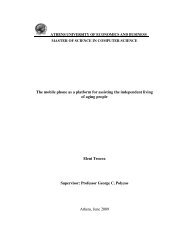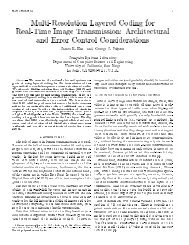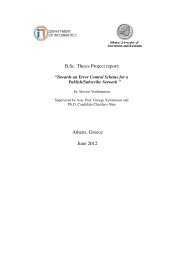In Network Processing and Data Aggregation in
In Network Processing and Data Aggregation in
In Network Processing and Data Aggregation in
You also want an ePaper? Increase the reach of your titles
YUMPU automatically turns print PDFs into web optimized ePapers that Google loves.
1 <strong>In</strong>troductionRecently, the technological advancements <strong>in</strong> hardware have led to the design ofextremely powerful chips. Gordon E. Moore stated <strong>in</strong> 1965 that the complexity of<strong>in</strong>tegrated circuits, with respect to m<strong>in</strong>imum component cost, doubles every 24 months.This “law” had hold for several years. However, on April 13 2005, Gordon Moorehimself stated <strong>in</strong> an <strong>in</strong>terview that the law may not hold valid for too long, s<strong>in</strong>cetransistors may reach the limits of m<strong>in</strong>iaturization at atomic levels. Now that thecomputational speed is bounded by physical limitations, the <strong>in</strong>terest of hardware expertshas been attracted to m<strong>in</strong>iaturization of devices. The new trend of compact<strong>in</strong>g thesystems enabled the development of co<strong>in</strong>-sized comput<strong>in</strong>g devices that are capable ofproduc<strong>in</strong>g digital representations of real-world phenomena. These devices are widelyknown as wireless sensors <strong>and</strong> they usually consist of sens<strong>in</strong>g, data process<strong>in</strong>g, <strong>and</strong>communicat<strong>in</strong>g components. The ability to communicate with each other throughwireless <strong>in</strong>terfaces enables the deployment of a big number of sensor nodes <strong>in</strong> a fieldform<strong>in</strong>g a wireless sensor network (WSN). <strong>In</strong> order for sensors to be both small <strong>and</strong><strong>in</strong>expensive, they have several resource constra<strong>in</strong>ts:Low b<strong>and</strong>width communication – The b<strong>and</strong>width of wireless l<strong>in</strong>ks is usually limitedto a few hundred Kbps. <strong>Network</strong> doesn’t provide quality of service, the latency is highlyvariable <strong>and</strong> the loss of a packet is a frequent phenomenon.Power consumption – Most of the times sensors are battery powered. The batteriesthat are used are non rechargeable, irreplaceable <strong>and</strong> very small. Therefore, whiletraditional networks aim to achieve high quality of service, sensor network protocolsfocus primarily on power conservation. Prolong<strong>in</strong>g the network’s lifetime is the ma<strong>in</strong>goal. <strong>In</strong> addition to that a WSN must support parameterized trade-off mechanisms thatprovide the end user with the option of prolong<strong>in</strong>g network lifetime at the cost of lowerthroughput or higher transmission delay.Computation – The node has limited computational power but it is usually adequate tocover the needs of the communication, application <strong>and</strong> sens<strong>in</strong>g activities.Sens<strong>in</strong>g accuracy – Signal process<strong>in</strong>g functions convert physical events <strong>in</strong>to <strong>in</strong>ternaldata representations. Sensed data, due to limitations of the sensor, may conta<strong>in</strong>








